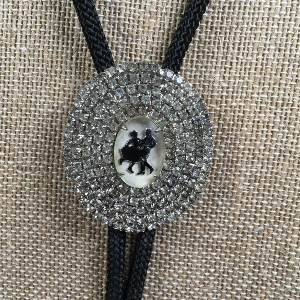Affiliate Disclaimer: We work to provide bolo ties and locate merchants who sell the products you are looking for. If you make a purchase from any of the merchants we endorse, we will earn a small commission at no additional cost to you. Thank you for your support!
Bolo Ties for Square Dancers
 Square dancing may seem like something out of Little House on the Prairie, but it has been a popular form of entertainment in the United States for generations.
Square dancing may seem like something out of Little House on the Prairie, but it has been a popular form of entertainment in the United States for generations.Square dancing was "essential" for generations of Americans up until the late 1800s, according to the Square Dance History Project. It went out of popularity at the time, but was revitalized following World War II, when it "enjoyed millions of participation." But where did it originate?
According to History.com, many European dances are claimed to have impacted the development of square dance: Morris dancing, which goes back to the 1600s in England; quadrille and cotillion dances performed in squares by 18th-century French couples; and "folk dances in Scotland, Scandinavia, and Spain." According to the website, this effect is obvious: "Europeans brought both folk and popular dancing traditions to England's 13 North American colonies when they arrived. In the years after the American Revolution, when many former colonies shunned all things British, French dance styles rose to prominence. 'Promenade,' 'allemande,' and the indispensable 'do-si-do,' a corruption of 'dos-ã-dos,' meaning 'back-to-back,' are all French terms used in modern square dancing."
However, square dancing was influenced by more than only European dances. In his book, Phil Jamison, a well-known square dance caller and square dance historian who oversees the Square Dance History project, says that African American and Native American dance styles, in addition to European dances, contributed to the creation of square dance.
According to History.com, calling, which was not a component of square dancing until the nineteenth century, "developed an art form in its own right, comedy, and entertainment." "Contributed their own dances and tunes to the heritage," black callers and musicians said.
According to Jamison's book, Native American impact on American social dance culture extends back to the 1600s, when a Native American fiddler-the sole fiddler in Maine-provided music for social dances. At the same time, cultural mixing resulted in "European social dances being performed alongside Native American ceremonial dances in Native American societies by the early 1800s." These influences also influenced him in the opposite direction, he writes. Square dancing, like almost everything else in American history, is a synthesis of several cultures and eras.







![TOTYg Vintage 1987 Square Dance Bolo Tie Red Enamel Cast Siskiyou [No Tie]](https://i.ebayimg.com/images/g/n0cAAOSwMipnICXM/s-l225.jpg)

